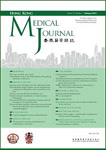
Continuous femoral nerve blockade versus patient-controlled analgesia following TKA

Continuous femoral nerve blockade versus patient-controlled analgesia following TKA
Elective unilateral total knee replacement using continuous femoral nerve blockade versus conventional patient-controlled analgesia: perioperative patient management based on a multidisciplinary pathway
Hong Kong Med J. 2014 Feb;20(1):45-51. doi: 10.12809/hkmj133899. Epub 2013 Sep 11.Did you know you're eligible to earn 0.5 CME credits for reading this report? Click Here
Synopsis
60 patients undergoing unilateral elective total knee arthroplasty under spinal anaesthesia were randomized to undergo a newly-proposed multidisciplinary postoperative treatment protocol involving multimodal analgesia and either continuous femoral nerve blockade (CFNB) or conventional patient-controlled analgesia (PCA). The purpose of this study was to compare clinical and functional outcomes asso...
To view the full content, login to your account,
or start your 30-day FREE Trial today.
FREE TRIAL
LOGIN
Forgot Password?
Explore some of our unlocked ACE Reports below!

Learn about our AI Driven
High Impact Search Feature
Our AI driven High Impact metric calculates the impact an article will have by considering both the publishing journal and the content of the article itself. Built using the latest advances in natural language processing, OE High Impact predicts an article’s future number of citations better than impact factor alone.
Continue



 LOGIN
LOGIN

Join the Conversation
Please Login or Join to leave comments.